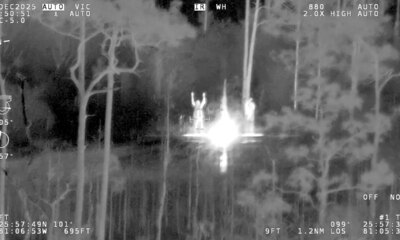Austin, TX
Texas weather: Will forecasted rain put a dent in drought?

AUSTIN, Texas – In December, the Barton Springs/Edwards Aquifer Conservation District declared Stage IV Exceptional Drought for the first time in its history.
With rain forecasted for Central Texas next week, the district will continue to monitor the Edwards Aquifer using two markers: Barton Springs and the Lovelady Monitor Well.
“What I’m most excited about for the forecast is this notion of maybe a prolonged period, multiple days of rain, and that’s what we really need,” said Dr. Tim Loftus, general manager of BSEACD. “Four inches that falls in one hour versus four inches that falls over two days has a very different effect on the relationship between what runs off and what actually soaks into the ground.”
Loftus said all eyes will be on Lovelady to see how it responds. Right now, it is just under the Stage IV threshold.
“It may be a couple of weeks before we really have a good feel because Lovelady’s response is definitely more muted than flow at Barton Springs,” said Loftus.
Exceptional drought declared in central Texas
For the first time in its 36-year history, the Barton Springs/Edwards Aquifer Conservation District is declaring a stage four exceptional drought.
RELATED
The Highland Lakes serve as another primary water source for Central Texas, including the City of Austin.
The forecast there is less hopeful.
“Everything that we’re seeing is that it’s not going to rain where we need it to…we need it to rain in the watershed. We need above Burnet and Llano to get rain so it can flow down,” said Shannon Hamilton, executive director of the Central Texas Water Coalition. “It’s going to take 8 to 10 inches over the watershed for us really to make a dent in our lakes.”
Lake Travis and Lake Buchanan are currently 42% full, according to LCRA.
The graph below shows historical water flow into these lakes.
Hamilton noted their hydrologist is projecting mandatory water cut-offs by next October if water levels and inflows don’t improve.
“Our water management plan depends on historical averages, but we don’t have that any longer,” said Hamilton. “The new trend is much less water coming in, and that’s what we have to plan for.”
Hamilton emphasized the importance of year-round water conservation.
In the wintertime, that may mean quickly fixing broken pipes or putting time limits on hot showers.
“Be mindful that when it comes above freezing, and you can turn off your faucets (after dripping), go turn them back off. And everybody’s irrigation system should be off right now,” said Hamilton. “So it’s little things, but all those things add up because we are still dropping – every day we’re dropping.”
This month, BSEACD announced the installation of two new monitoring wells beginning in January. One will be located in Garrison Park and one will be in Zilker Park.
The Garrison well will be “used to collect Edwards Aquifer water level and water quality data,” according to BSEACD. The Zilker well will be a multiport well that is “capable of monitoring multiple aquifer zones, providing a more in-depth and comprehensive understanding of the aquifer at hand.”

Austin, TX
Fire destroys abandoned E Austin auto shop

AUSTIN, Texas — Austin firefighters battled their second major fire Thursday afternoon, responding to an abandoned East Austin auto shop engulfed in flames.
Crews responded to 3100 Manor Road around 4 p.m., AFD said.
No injuries were reported and no one was inside the building.
ALSO | 40+ residents displaced in North Austin third-alarm apartment fire, no injuries reported
The incident was called in as a first alarm. The building is a total loss, according to officials.
CBS Austin has a crew on the way to the scene.
BE THE FIRST TO COMMENT
Earlier in the afternoon, firefighters extinguished a three-alarm fire in north Austin.
Austin, TX
Austin road rage suspect identified, charged with criminal mischief: affidavit

AUSTIN, Texas – The suspect in a violent road rage incident on the Capital of Texas Highway has been identified and charged, according to court paperwork.
The altercation was caught on camera.
What we know:
34-year-old Ian Kevin Brinkmeyer has been charged with criminal mischief, a Class B misdemeanor, in connection with the Dec. 5 incident.
At around 2 p.m. that day, officers responded to a call for service on Capital of Texas Highway, where they spoke with Brinkmeyer and another man.
The affidavit says Brinkmeyer “engaged in a road rage” with the other man while traveling north on Capital of Texas Highway. Brinkmeyer drove around the other man, changed lanes in front of him and cut him off before stopping his car.
Brinkmeyer then allegedly got out of his vehicle holding a “steel knife sharpening rod”, walked over to the other man’s car and struck the driver’s side door window with the rod, shattering the entire window.
The affidavit says Brinkmeyer then quickly walked back to his car and drove off.
The entire incident was caught on video by other drivers and posted on social media.
The affidavit says that the repairs to the shattered window cost about $480, making this a case of criminal mischief with a value between $100 and $750.
What’s next:
A warrant has been issued for Brinkmeyer’s arrest. As of 12 p.m. Dec. 11, he is not in custody.
The Source: Information in this report comes from court paperwork and previous reporting.
Austin, TX
Day Trips: Gifts From All Over Texas • The Austin Chronicle

Holiday gift giving means it’s time for a road trip.
Maceo’s Spice & Import Company (maceospice.com) in Galveston is the perfect destination for the chefs and eaters on your list. Not only is the island city decorated for the holidays, but the 81-year-old specialty shop has an expansive selection of spices and hard-to-find imported foods. The house-made tomato gravy and pesto sauce are highly recommended. While you’re there, treat yourself to a muffaletta sandwich and a bowl of gumbo.
If someone on your holiday gift list is a New Orleans Jazz and Heritage Festival fan, head to Santo at the intersection of I-20 and U.S. 281. Kennedy’s Sausage Hometown Market (kennedyssausagehtm.com) makes the original Crawfish Monica Sauce (minus the crawfish) from Jazz Fest. The market sells other frozen foods that can be found nowhere else except maybe their other store in Stephenville.
At Santo you’re 16 miles south of Mineral Wells, so drive to the Crazy Water Company for a case of Texas’ original mineral water.
If you can’t make a road trip during the hectic days leading up to the holiday, then shop online. One of the pleasures of traveling Texas is finding the friendly voice of National Public Radio. Small radio stations were hit hard after the elimination of federal funding for public media. For instance, Marfa Public Radio lost a third of its funding. Consider making a gift to one of the 44 public stations in Texas in someone’s name. Or purchase a very cool T-shirt from Marfa Public Radio (marfapublicradio.org) as a way of making a donation.
Want a gift with staying power? Give a personalized brick to support the renovation of the historic Bolivar Point Lighthouse (bolivarpointlighthouse.org). The red brick with their name on it will be used as a paving stone at the lighthouse across the channel from Galveston.

Feliz Navidad, y’all.
1,784th in a series. Everywhere is a day trip from somewhere. Follow “Day Trips & Beyond,” a travel blog, at austinchronicle.com/day-trips.
This article appears in December 12 • 2025.
-

 Alaska6 days ago
Alaska6 days agoHowling Mat-Su winds leave thousands without power
-

 Politics1 week ago
Politics1 week agoTrump rips Somali community as federal agents reportedly eye Minnesota enforcement sweep
-
Ohio1 week ago
Who do the Ohio State Buckeyes hire as the next offensive coordinator?
-

 Texas6 days ago
Texas6 days agoTexas Tech football vs BYU live updates, start time, TV channel for Big 12 title
-

 News1 week ago
News1 week agoTrump threatens strikes on any country he claims makes drugs for US
-

 World1 week ago
World1 week agoHonduras election council member accuses colleague of ‘intimidation’
-

 Washington3 days ago
Washington3 days agoLIVE UPDATES: Mudslide, road closures across Western Washington
-

 Iowa5 days ago
Iowa5 days agoMatt Campbell reportedly bringing longtime Iowa State staffer to Penn State as 1st hire






















